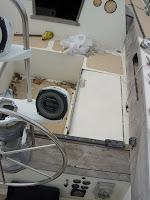 |
| View through the Center Hatch Opening |
One look at this picture and you wonder why I ever started the project! Here the original headliner, held in place with mahogany battens screwed to the plywood strips that are glassed in place from side to side at roughly 18 inch intervals along the cabin top, has been removed to reveal the structure of the boat. Note that the boat does not have a balsa cored cabin deck -- it is just thick (nearly 1/2 inch) fiberglass. There is a core (or rather a bottom layer) of plywood on all other deck areas. This has served very well. There is no delamination or core rot that I can detect although I am sure this construction technique makes the boat relatively heavy by today's standards.
 |
The Plywood Under a Side Deck (Foam
Headliner Partially Removed) |
The goal is to insulate between each of the plywood furing strips and then fashion laminate (like Formica) into panels spanning each furing pair. These panels will be covered with Naugasoft vinyl. Then we will secure them in place with velcro so they can be easily removed to access bolts securing deck hardware. The foam backed vinyl under the side decks will be replaced -- it will be glued back in place just as it was originally. This latter task will be covered in a future posting. Let's focus on the removable headliner here.
We decided to use 1/2 inch thick "R Board" available at any lumber company for the insulation between furing strips. This is the same foam panel used to side houses. It has a rigid foam core sandwiched on both sides with construction paper. The board can easily be cut to shape with a utility knife. Then a quick acting contractors adhesive like Lock Tight "Grab It" can be used to secure it in place. Where there is some curvature required shallow slits can be cut on one side of the R Board to make it bend more readily. Lengths of nested tubing or clamped together boards can be used to prop the boards firmly in place until the glue dries.
 |
| Velcro Secured Headliner Panels |
Two inch wide adhesive backed velcro hook tape is secured to the furring strips so its center line will be on the joint formed by two headliner panels. The ends of this tape can be stapled in place at intervals with monel staples to insure that they stay in place, but the adhesive can be surprisingly effective if the tape is applied with the temperature between 50 and 80 degrees and if the humidity is not extremely high. Do realize that the adhesive will gain strength for the first week or so -- it is a good idea to apply the tape and then come back to it a week or so later to install the headliner panels.
 |
The Angle Grinder with a
Diamond Cutting Masonary Wheel |
The panels themselves can be cut from laminate counter top material. We picked up ours at a local Manards big box store (Lowes has a similar material). Cutting this stuff can be a daunting task. It comes in big sheets that are rather fragile. And the blade of a table saw can fracture and split the edges if the material is not carefully supported as it is cut. I found the best cutting technique is to use a masonary cutting wheel (the expensive $40 diamond kind) in a small angle grinder for laminate cutting. I suspect that a cutting wheel in a Dremel tool would work nicely as well but it would be a bit slower. In any case, once the laminate is roughly cut it can be trimmed easily with a pair of shears (so long as the cut away material is less than 1/4 inch or so -- that way the waste material can be sloughed away as the cut proceeds).
Once cut to shape, I used 3M General Trim Adhesive to secure Naugasoft vinyl to the face of the laminate. Cut the Naugasoft with a 1 inch allowance all the way round. Truncate the corners so there is no overlap when the material is folded over onto the back side of the board. Apply more General Trim Adhesive to secure these folded flaps in place. Make sure the solvents are all evaporated from the adhesive before contacting the two glued faces since it will not evaporate through the vinyl or the board once contact has been made (wait 10 minutes or so before pressing everything together). As in the case of the Velcro adhesive tape above, a temperature range of from 50 to 80 degrees and low humidity seems to encourage strong bonds and a careful cleaning of all surfaces with 3M General Adhesive Remover prior to applying the glue also increases the strength of the bond.
When the vinyl/panel assemblies are dry (a day or so later), Velcro adhesive backed 1 inch loop tape can be applied to the appropriate edges. Follow all of the application tips described above.













